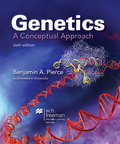
a.
To determine:
The typical eukaryotic gene and the
Introduction:
The typical eukaryotic gene consists of an exon, intron, promoter sequence, a terminator sequence, upstream sequence, downstream sequence, enhancer,and silencer. A eukaryotic gene transcribes in the m-RNA followed by protein synthesis.
a.
Explanation of Solution
Pictorial representation:
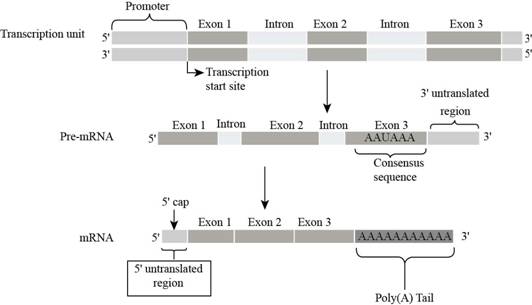
Fig.1:
RNA containsan
In the figure
b.
To determine:
The typical eukaryotic gene and the
Introduction:
The typical eukaryotic gene consists of an exon, intron, promoter sequence, a terminator sequence, upstream sequence, downstream sequence, enhancer,and silencer. A eukaryotic gene transcribes in
b.
Explanation of Solution
Pictorial representation:
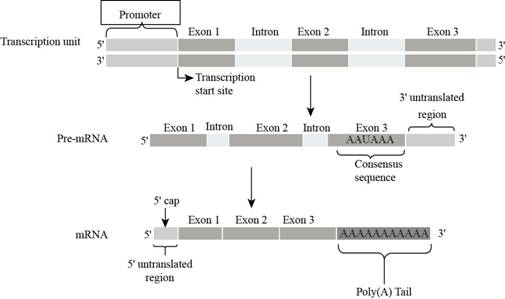
Fig. 2: Promoter.
DNA contains a promoter region in the transcription unite on which RNA polymerase binds in order to start the transcription. It is present upstream to the structural gene, and next to the transcription start site.
In the figure promoter present before the exon 1 on the DNA strand.
c.
To determine:
The typical eukaryotic gene and the
Introduction:
The typical eukaryotic gene consists of an exon, intron, promoter sequence, a terminator sequence, upstream sequence, downstream sequence, enhancer,and silencer. A eukaryotic gene transcribes in
c.
Explanation of Solution
Pictorial representation:
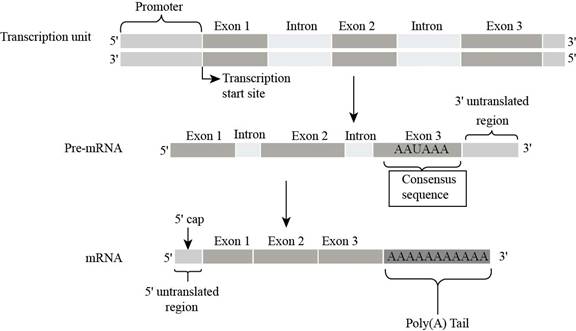
Fig. 3:
In eukaryotic
In the figure
d.
To determine:
The typical eukaryotic gene and the
Introduction:
The typical eukaryotic gene consists of an exon, intron, promoter sequence, a terminator sequence, upstream sequence, downstream sequence, enhancer,and silencer. A eukaryotic gene transcribes in
d.
Explanation of Solution
Pictorial representation:
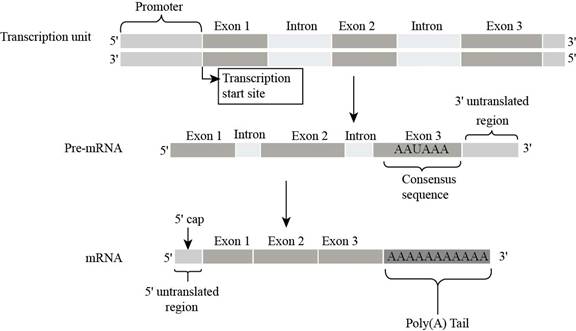
Fig. 4: Transcription start site
The actual site from where the transcription initiation occurs on the DNA template, is termed as transcription start site.
In figure transcription start site present within the starting of exon 1 on DNA strand.
e.
To determine:
The typical eukaryotic gene and the
Introduction:
The typical eukaryotic gene consists of an exon, intron, promoter sequence, a terminator sequence, upstream sequence, downstream sequence, enhancer,and silencer. A eukaryotic gene transcribes in
e.
Explanation of Solution
Pictorial representation:
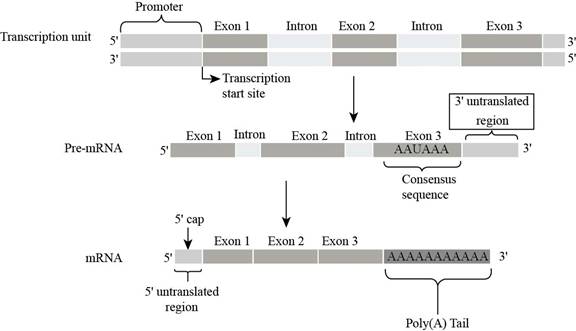
Fig. 5:
The
In the figure
f.
To determine:
The typical eukaryotic gene and the
Introduction:
The typical eukaryotic gene consists of an exon, intron, promoter sequence, a terminator sequence, upstream sequence, downstream sequence, enhancer,and silencer. A eukaryotic gene transcribes in
f.
Explanation of Solution
Pictorial representation:
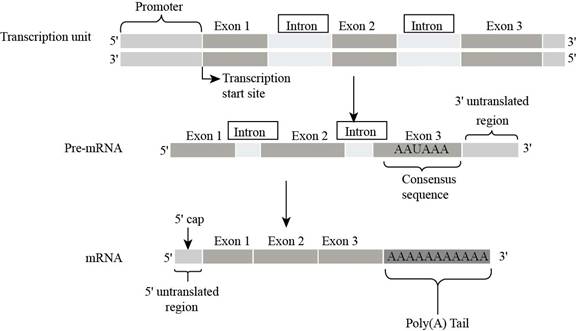
Fig. 6: Introns
DNA contains a particular sequence of
Introns are present in-between the coding sequence (gene) of DNA. Introns are transcribed and produce, but during the splicing process of RNA transcript, the intron segment is eliminated, hence do not code proteins.
In the figure, one intronsis present exon1 and exon2, and second introns are present in between exon 2 and exon 3, on DNA and
g.
To determine:
The typical eukaryotic gene and the
Introduction:
The typical eukaryotic gene consists of exon, intron, promoter sequence, terminator sequence, upstream sequence, downstream sequence, enhancer and silencer. A eukaryotic gene transcribe in
g.
Explanation of Solution
Pictorial representation:
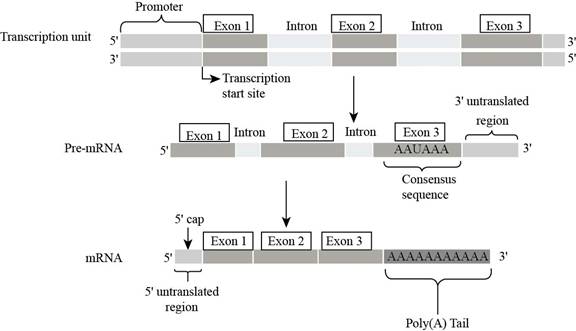
Fig. 7: Exons.
DNA contains a particular sequence of nucleotide which codes for a particular protein, termed as gene. Gene contains the coding regions which codes a particular functional protein is termed as exon.
In the figure, coding sequences marked as exon1, exon 2 , and exon 3, on DNA
h.
To determine:
The typical eukaryotic gene and the
Introduction:
The typical eukaryotic gene consists of exon, intron, promoter sequence, terminator sequence, upstream sequence, downstream sequence, enhancer and silencer. A eukaryotic gene transcribe in
h.
Explanation of Solution
Pictorial representation:
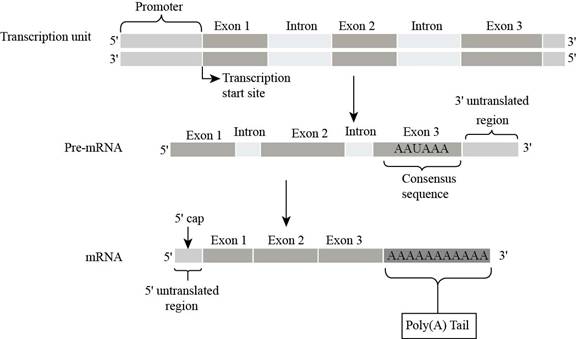
Fig. 8: Poly (A) tail
Eukaryotic
In the figure, poly (A) tail present on the
i.
To determine:
The typical eukaryotic gene and the
Introduction:
The typical eukaryotic gene consists of exon, intron, promoter sequence, terminator sequence, upstream sequence, downstream sequence, enhancer and silencer. A eukaryotic gene transcribe in
i.
Explanation of Solution
Pictorial representation:
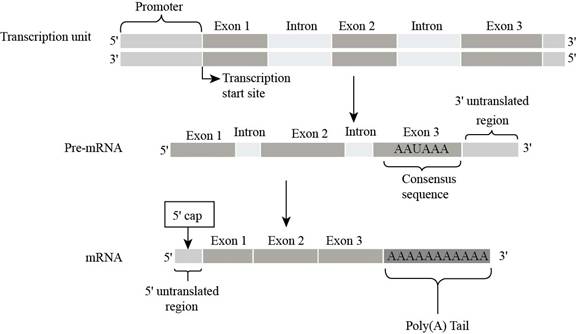
Fig. 9:
Eukaryotic
In the figure,
Want to see more full solutions like this?
Chapter 14 Solutions
Genetics: A Conceptual Approach
- please fill in the empty sports, thank you!arrow_forwardIn one paragraph show how atoms and they're structure are related to the structure of dna and proteins. Talk about what atoms are. what they're made of, why chemical bonding is important to DNA?arrow_forwardWhat are the structure and properties of atoms and chemical bonds (especially how they relate to DNA and proteins).arrow_forward
- The Sentinel Cell: Nature’s Answer to Cancer?arrow_forwardMolecular Biology Question You are working to characterize a novel protein in mice. Analysis shows that high levels of the primary transcript that codes for this protein are found in tissue from the brain, muscle, liver, and pancreas. However, an antibody that recognizes the C-terminal portion of the protein indicates that the protein is present in brain, muscle, and liver, but not in the pancreas. What is the most likely explanation for this result?arrow_forwardMolecular Biology Explain/discuss how “slow stop” and “quick/fast stop” mutants wereused to identify different protein involved in DNA replication in E. coli.arrow_forward
- Molecular Biology Question A gene that codes for a protein was removed from a eukaryotic cell and inserted into a prokaryotic cell. Although the gene was successfully transcribed and translated, it produced a different protein than it produced in the eukaryotic cell. What is the most likely explanation?arrow_forwardMolecular Biology LIST three characteristics of origins of replicationarrow_forwardMolecular Biology Question Please help. Thank you For E coli DNA polymerase III, give the structure and function of the b-clamp sub-complex. Describe how the structure of this sub-complex is important for it’s function.arrow_forward
 Human Anatomy & Physiology (11th Edition)BiologyISBN:9780134580999Author:Elaine N. Marieb, Katja N. HoehnPublisher:PEARSON
Human Anatomy & Physiology (11th Edition)BiologyISBN:9780134580999Author:Elaine N. Marieb, Katja N. HoehnPublisher:PEARSON Biology 2eBiologyISBN:9781947172517Author:Matthew Douglas, Jung Choi, Mary Ann ClarkPublisher:OpenStax
Biology 2eBiologyISBN:9781947172517Author:Matthew Douglas, Jung Choi, Mary Ann ClarkPublisher:OpenStax Anatomy & PhysiologyBiologyISBN:9781259398629Author:McKinley, Michael P., O'loughlin, Valerie Dean, Bidle, Theresa StouterPublisher:Mcgraw Hill Education,
Anatomy & PhysiologyBiologyISBN:9781259398629Author:McKinley, Michael P., O'loughlin, Valerie Dean, Bidle, Theresa StouterPublisher:Mcgraw Hill Education, Molecular Biology of the Cell (Sixth Edition)BiologyISBN:9780815344322Author:Bruce Alberts, Alexander D. Johnson, Julian Lewis, David Morgan, Martin Raff, Keith Roberts, Peter WalterPublisher:W. W. Norton & Company
Molecular Biology of the Cell (Sixth Edition)BiologyISBN:9780815344322Author:Bruce Alberts, Alexander D. Johnson, Julian Lewis, David Morgan, Martin Raff, Keith Roberts, Peter WalterPublisher:W. W. Norton & Company Laboratory Manual For Human Anatomy & PhysiologyBiologyISBN:9781260159363Author:Martin, Terry R., Prentice-craver, CynthiaPublisher:McGraw-Hill Publishing Co.
Laboratory Manual For Human Anatomy & PhysiologyBiologyISBN:9781260159363Author:Martin, Terry R., Prentice-craver, CynthiaPublisher:McGraw-Hill Publishing Co. Inquiry Into Life (16th Edition)BiologyISBN:9781260231700Author:Sylvia S. Mader, Michael WindelspechtPublisher:McGraw Hill Education
Inquiry Into Life (16th Edition)BiologyISBN:9781260231700Author:Sylvia S. Mader, Michael WindelspechtPublisher:McGraw Hill Education





